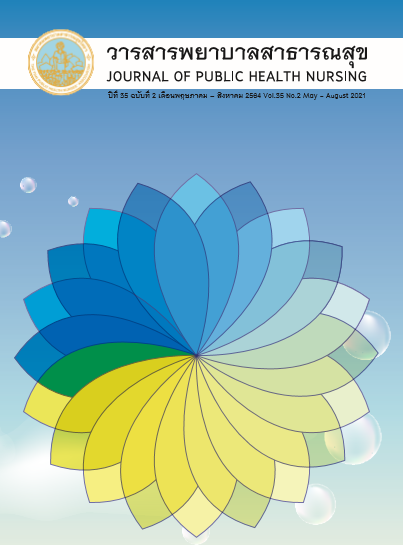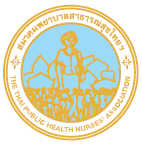Factors Related to Fabric Hygienic Mask Wearing Behaviors to Prevent COVID-19 among People in Pathumthani Province
Keywords:
Behaviors, Cloth mask, COVID-19, Cognitive-perceptual factorsAbstract
Wearing a fabric hygienic or cloth mask can be used to prevent the spread of the coronavirus 2019 in situations where surgical masks are scarce. This descriptive research aimed to study the factors related to cloth mask utilization behavior in COVID-19 prevention of peoples in Pathumthani Province. The study samples consisted of 315 people. Data were collected using 3 questionnaires; the demographic data record form, cloth mask behavior, and Cognitive-Perceptual factors of Pender’s health promotion model (HPM); perceived benefit, perceived barriers, self-efficacy, interpersonal influence, and situational influence. The content validity test was at 1.00, and the reliability test was conducted using Cronbach’s alpha coefficient at .80 and .85. Statistics used for data analysis consisted of Spearman’s s Correlation and Pearson’s Product Moment Correlation coefficient.
The study results showed that education level and cognitive-perceptual factors including perceived benefit and situational influence were statistically significant related to cloth mask utilization behavior (r = -.157, .366 and .216 consecutively).
The study results should be used as a guideline to promote the perception of benefits and the correct information of situation for cloth masks using to prevent infection.
References
Eurosurveillance Editorial Team. Note from the editors: World Health Organization declares novel coronavirus (2019-nCoV) sixth public health emergency of international concern. Eurosurveillance 2020; 25(5): 200131e.
News Action Center for Coronavirus Disease 2019. News report on coronavirus infection 2019 [internet]. 2021 [cited 2021 Mar 17]. Available from: https://ddc.moph.go.th/viralpneumonia/file/situation/situation-no439-170364.pdf
Ballestero MFM, de Oliveira RS. The covid-19 outbreak and pediatric neurosurgery guidelines. Archives of Pediatric Neurosurgery 2020; 2(1): 53-4.
Wu Z, McGoogan JM. Characteristics of and important lessons from the coronavirus disease 2019 (COVID-19) outbreak in China: Summary of a report of 72,314 cases from the Chinese Center for Disease Control and Prevention. Jama 2020; 323(13): 1239-42.
Fisher D, Heymann D. Q&A: The novel coronavirus outbreak causing Covid -19. BMC medicine 2020; 18(1): 1-3.
Ganyani T, Kremer C, Chen D, Torneri A, Faes C, Wallinga J, et al. Estimating the generation interval for coronavirus disease (COVID-19) based on symptom onset data, March 2020. Eurosurveillance 2020; 25(17): 2000257. doi.org/10.2807/1560-7917.ES.2020.25.17.2000257
Watsamon C. Protection Beating Connect the Aviros Corona 2019, document Accompanying the lecture on the 23rd Chula Session Forum: Better than frightened Learn and prevent Coronavirus 2019; 2020, February 20; Bangkok: Department of Pediatrics Faculty of Medicine Chulalongkorn University; 2020.
Suraiya M, Sopon I, Sumonmal U. Coronavirus Disease-19 (COVID-19). Journal of Bamrasnaradura Infectious Diseases Institute 2020; 14(2): 124-33. (in Thai)
Rothe C, Schunk M, Sothmann P, Bretzel G, Froeschl G, Wallrauch C, et al. Transmission of 2019-nCoV infection from an asymptomatic contact in Germany. New England Journal of Medicine 2020; 382(10): 970-1.
Bedford J, Enria D, Giesecke J, Heymann DL, Ihekweazu C, Kobinger G, et al. COVID-19: towards controlling of a pandemic. The Lancet 2020; 395(10229): 1015-8.
Covid CD, Team R, COVID C, Team R, COVID C, Team R, et al. Severe Outcomes Among Patients with Coronavirus Disease 2019 (COVID-19)-United States, February 12–March 16, 2020. Morbidity and mortality weekly report 2020; 69(12): 343-6. doi: 10.15585/mmwr.mm6912e2
Thavorn Charoensap M. How to properly use face mask during the COVID-19 [internet]. 2020 [cited 2021 July 10]. Available from: http://healthydee.moph.go.th/backend/fileAttach/23072020_083646-0000003722.pdf
MacIntyre CR, Seale H, Dung TC, Hien NT, Nga PT, Chughtai AA, et al. A cluster randomised trial of cloth masks compared with medical masks in healthcare workers. BMJ open 2015; 5(4): e006577.
Davies A, Thompson K, Giri K, Kafatos G, Walker J, Bennett A. Testing the efficacy of homemade masks: Would they protect in an influenza pandemic? Disaster Medicine and Public Health Preparedness 2013; 7(4): 413–8.
World Health Organization. Advice on the use of masks in the context of COVID-19: interim guidance, 5 June 2020 [internet]. 2020 [cited 2021 July 10]. Available from: https://www.who.int/docs/default-source/searo/thailand/who-2019-ncov-ipc-masks-2020-4-th.pdf?sfvrsn=61f46597_2
Department of Disease Control. Situation report of coronavirus disease 2019 No. 173, on 24 June 2020 [internet]. 2020 [cited 2021 July 10]. Available from: https://ddc.moph.go.th/viralpneumonia/file/situation/situation-no173-240663n.pdf
Rizki SA, Kurniawan A. Efficacy of Cloth Mask in Reducing COVID-19 Transmission: A Literature Review. Kesmas: Jurnal Kesehatan Masyarakat Nasional (National Public Health Journal) 2020; Special Issue 1: 43-8. doi: 10.21109/kesmas.v15i2.3893
De Sousa Lima MM, Leandro Cavalcante MF, Sales Macêdo T, Galindo-Neto MN, Áfio Caetano J, Moreira Barros L. Cloth face masks to prevent Covid-19 and other respiratory infections. Revista latino-americana de enfermagem 2020; 28: e3353. doi: 101590/1518-8345.4537.3353
Pender NJ, Murdaugh CL, Parsons MA. Health promotion in nursing practice. 5th ed. Jurong, Singapore: Pearson; 2006.
Pender NJ, Murdaugh CL, Parsons MA. Health promotion in nursing practice. 4th ed. Upper Saddle River, NJ: Pearson; 2002.
Wannee K. Research Methodology in Behavioral Sciences. 3rd ed. Bangkok: Chulalongkorn University; 2012.
Jaruwan L, Chanandchidadussadee T, Pornnapa H. Factors influencing on preventive behaviors of respiration tract infections among caregivers of preschool aged children in childcare, Bangkok metropolitan administration. Journal of Public Health Nursing 2019; 33(1): 1-19. (in Thai)
Khuanjai M, Jeeraporn K, Wanalada T. The factors predicting tuberculosis preventive behaviors among the tuberculosis contacts in the bangkok area and perimeter. Journal of the Royal Thai Army Nurses 2019; 18(Suppl): 306-14. (in Thai)
Downloads
Published
How to Cite
Issue
Section
License
บทความที่ตีพิมพ์และแผนภูมิรูปภาพถือเป็นลิขสิทธิ์ของวารสารพยาบาลสาธารณสุข (Thai Public Health Nurses Association)







